Choosing Paddle Boards for Larger Individuals
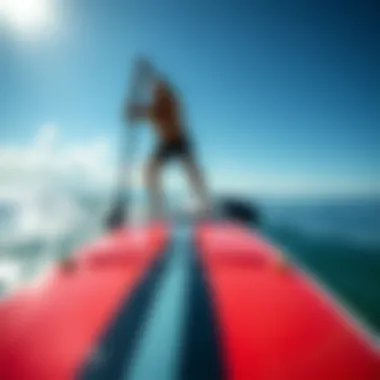
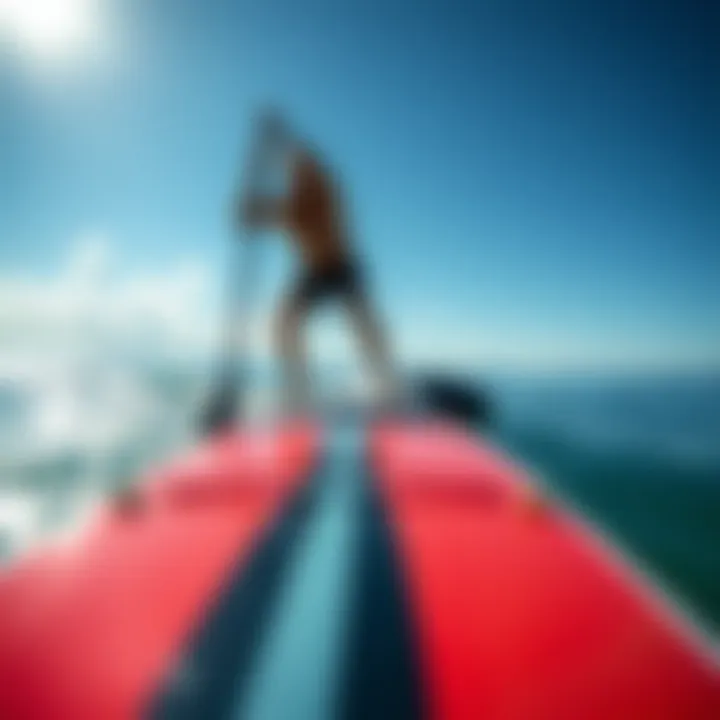
Intro
Paddle boarding has become a beloved outdoor activity for many, offering a blend of fun, fitness, and connection with nature. However, for larger individuals, the selection process can be a bit more nuanced. Navigating the market can feel like finding a needle in a haystack, especially when so many paddle boards cater to a general audience. Understanding how to choose the right paddle board specifically designed for larger individuals is crucial to ensuring both safety and enjoyment on the water.
This guide sets out to provide you with a detailed look at key considerations like size, stability, and weight capacity. We’ll also dive into the various types of paddle boards available, materials used in their construction, and essential features that enhance performance. When you’re out there on the water, it’s essential that you feel confident both in your gear and your abilities.
So, whether you’re looking to cruise along calm lakes or tackle ocean waves, let’s explore how to select a paddle board that truly fits your needs, allowing you to soak up every moment under the sun.
Gear and Equipment
Selecting the right paddle board goes beyond just picking the first model you see. There’s a variety of gear and equipment specially tailored for larger individuals. The right board can make a world of difference in terms of stability, comfort, and overall performance.
Key Features to Consider
When searching for your paddle board, keep these features on your radar:
- Width: Opt for a wider board. A board measuring 30 inches or more will usually offer the stability necessary for larger paddlers.
- Length: Longer boards often provide better tracking and glide on the water. Consider boards around 10-12 feet for better performance.
- Weight Capacity: Check the manufacturer's specifications for weight limits. Heavier paddlers should ensure their board can easily support their weight plus additional gear.
- Material: Choose boards made from durable materials like fiberglass or a high-density polyethylene, which can withstand wear and tear, especially in rough conditions.
"A well-chosen paddle board not only enhances your performance but also elevates your overall experience on the water!"
Latest Paddle Board Technologies
The paddle board industry is not static; technological advancements have introduced features that significantly improve performance. Some of the latest trends include:
- Inflatable Paddle Boards (iSUPs): These are lightweight, easy to transport, and can accommodate larger individuals without compromising on buoyancy.
- Hybrid Designs: Some boards now feature designs that blend stability and maneuverability, perfect for both beginners and experienced paddlers.
- Anti-slip Footpads: Always a good idea for larger boards – they help ensure you maintain grip even in wet conditions.
Essential Accessories for Every Paddler
To enhance your paddle boarding experience, plenty of accessories can come in handy:
- Paddle: Look for an adjustable paddle that can be customized to your height and paddling style.
- Life Jacket: A comfortable and properly fitted life jacket is a must-have, ensuring safety while on the water.
- Leash: A leash keeps you connected to your board, preventing it from drifting away and ensuring a safer paddling experience.
- Dry Bag: Keep your belongings safe and dry, especially if you’re planning a full-day adventure.
By paying attention to these key elements, you are paving the way for an enjoyable paddle boarding experience tailored to your specific needs.
Understanding the Needs of Larger Paddle Boarders
When it comes to paddle boarding, not every board fits every rider. The focus on larger paddle boarders brings several unique needs to light, which are paramount for an enjoyable and safe experience. Understanding these requirements can vastly improve your time on the water, enhancing both comfort and performance.
One of the most critical factors for larger individuals is the weight capacity of the paddle board. This specification is not merely a number; it encompasses the total load the board can handle, including the rider's weight, gear, and any additional equipment. Choosing a board with insufficient weight capacity can lead to instability and a less enjoyable ride.
Another vital aspect is stability. Larger paddle boarders often require boards that offer a solid, stable platform to stand on. A stable board not only allows for easier paddling but also provides confidence against tipping in unpredictable water conditions. Stability is often associated with the design and size of the board, including its width and length.
Lastly, comfort and performance cannot be understated. A board that accommodates larger paddlers should also ensure that they can have fun while moving efficiently across water. This balance can often be achieved through a combination of width, height considerations, and the right choice of accessories.
In essence, tailoring your choice to meet these specific needs is crucial. Riders who are aware of their requirements can significantly elevate their paddle boarding experience, blending enjoyment with safety. By diving into these specifics, paddlers can make empowered decisions, ensuring they not only keep afloat but also have the best time out on the water.
"The best paddle board is the one that feels like an extension of you, not a clunky obstacle."
Recognizing Weight Capacity Requirements
Recognizing the weight capacity needs is the first step towards making the right decision. Paddle boards come with different weight limits, and for larger individuals, this is a pressing matter of concern. A board that cannot adequately support the rider's weight can become submerged, making it hard to maneuver and putting the rider at risk of capsize.
Typical weight limits often range from as low as 200 pounds to upwards of 600 pounds for specialized boards. Nonetheless, it's wise to consider a board that exceeds your weight needs slightly, allowing for gear or other loads. A board with higher weight capacity tends to have a more robust construction, which can increase its durability and lifespan.
Importance of Stability in Paddle Boarding
Design and Wider Surface Area
Stability is a key player when it comes to paddle boarding, especially for larger individuals. The board's design often incorporates a wider surface area, which plays an instrumental role in ensuring stability. A broader board naturally allows for more balanced weight distribution, which is essential for maintaining an upright position on the water.
Characteristics like full rails or a higher volume can help a board resist tipping. Wider boards often result in increased drag, but the trade-off is worth it for those prioritizing comfort. A well-designed wide board should be easy to steer, reducing the user’s effort on longer trips.
Impact of Weight Distribution
Another important consideration is how weight distribution affects balance on the board. For larger paddlers, where weight might be more centralized, it is imperative to understand how shifting or leaning can impact stability. If a board can distribute weight effectively—this prevents a tipping sensation which distracts from the enjoyment of the ride.


A paddle board that has a well-thought-out design concerning weight distribution enhances the overall riding experience. It allows the user to move freely without the constant worry of tipping over, making it a popular choice among larger individuals.
Balancing Comfort and Performance
Choosing the Right Width
The width of a paddle board can have a significant influence on how comfortable and effective a rider can be on it. Wider boards provide a sturdy platform to stand on, making it easier to maintain balance, particularly for larger individuals. However, one must find a balance here, as excessively wide boards might hinder speed and maneuverability.
Optimal width often sits between 30 to 34 inches for larger riders. This width range can accommodate extra paddler weight while still allowing for decent tracking and performance when paddling in flat water or even choppy conditions.
Height Considerations
Height is another factor worth paying attention to, especially in relation to paddle length and stance. Taller paddle boarders will generally benefit from adjustable paddle lengths to suit their unique needs, ensuring that they can paddle comfortably without straining their back or shoulders. A properly sized paddle aids in achieving an efficient stroke, promoting both comfort and performance.
In short, the interplay between width and height considerations is essential for creating an enjoyable paddle boarding experience. Riders must consider their height along with their weight to find the perfect balance. This careful thought can lead to more enjoyable days out on the water, with less fatigue and more overall satisfaction.
Types of Paddle Boards for Larger Individuals
When it comes to paddle boarding, the type of board you choose can make all the difference, especially for larger individuals. The right paddle board not only accommodates weight but also boosts confidence and enhances the overall experience on the water. In this section, we will delve into various types of paddle boards available in the market and highlight their specific attributes that cater to larger body types.
All-Around Paddle Boards
All-around paddle boards stand as one of the most versatile options for larger individuals. These boards are designed to handle a variety of conditions and are suitable for recreational paddling or even surfing small waves. They typically come in wider shapes, which provides added stability. An important feature of all-around boards is their ample weight capacity, often accommodating a range of body types, which makes them a popular choice among larger paddle boarders.
Their design allows for easy maneuverability and comfort, whether you’re gliding on a calm lake or navigating choppy waters. This type of paddle board plays nicely with beginners and those looking for a laid-back day on the water.
Touring Paddle Boards
Touring paddle boards are crafted for those who find joy in long distances. They are longer and sleeker, designed to cut through the water efficiently.
Long-Distance Stability
One of the standout characteristics of touring paddle boards is their long-distance stability. This allows for a smoother ride over extended periods, thus reducing fatigue. For larger paddle boarders, the stability factor becomes essential when paddling long stretches. Choices like the Naish Glide or the BIC Sport Borneo are prime examples that provide high stability without compromising on speed.
"A stable board leads to a smoother experience, especially during those long outings alongside friends."
This feature not only enhances confidence but also allows for better weight distribution while paddling. With this stability, you’re likely to feel grounded on the board, steering clear of any potential tipping over in varying water conditions.
Design for Efficiency
The design for efficiency in touring boards is particularly notable. Their narrow profile allows for less resistance as you paddle, making it easier for larger paddlers to achieve longer distances without exhausting effort. The streamlined shape increases speed and makes it a preferred choice for those who may be heavier but still look for performance on the water. These boards often come with built-in carry handles and storage space, which adds to their practicality on longer journey.
Inflatable Paddle Boards
Inflatable paddle boards have garnered popularity over the years, and for good reason. They provide a fantastic combination of portability and performance, especially beneficial for larger individuals.
Convenience and Storage
The convenience and storage options that inflatable boards provide cannot be overstated. They can be deflated and rolled up to fit into a backpack, making them excellent for those with limited storage options or who travel frequently. For larger paddlers, this aspect means that you won’t have to deal with cumbersome boards taking up space.
They are lightweight when deflated, which is a welcome feature for those who may not want to heft heavy boards onto their vehicle. While on the water, a well-inflated paddle board can still provide ample stability and buoyancy, ensuring that larger individuals feel comfortable floating atop.
Durability and Weight Capacity
When discussing durability and weight capacity, inflatable boards have improved significantly. Many feature tougher materials like drop-stitch construction, which offer resilience against punctures while still being lightweight. For larger paddle boarders, it’s essential to select boards that can support their weight effectively without compromising the structure of the board.
Inflatable paddle boards typically have weight limits clearly outlined by manufacturers, and many can accommodate sizes upwards of 300 pounds. This characteristic makes them an appealing choice for larger individuals not only for stability while paddling but also when the board is being transported or stored away.
In summary, whether you opt for an all-around, touring, or inflatable board, understanding the types that cater specifically to larger individuals ensures a safer and more enjoyable journey on the water.
Choosing the Right Materials
When it comes to paddle boards, the materials used in their construction can make a world of difference, especially for larger individuals. Selecting the right materials is not just about personal preference; it affects the board's performance, durability, and overall user experience. The choice between rigid and inflatable boards can alter how the board behaves on the water, impacting both comfort and stability during paddling.
Rigid Boards versus Inflatable Boards
Engaging in the debate of rigid versus inflatable boards can feel like standing at the crossroads. Rigid boards, typically made from materials like epoxy and fiberglass, offer superior rigidity. They excel in providing a solid feel on the water, which can be particularly advantageous for larger paddle boarders who require greater stability. These boards are less prone to flex under weight, allowing for more precise paddling.
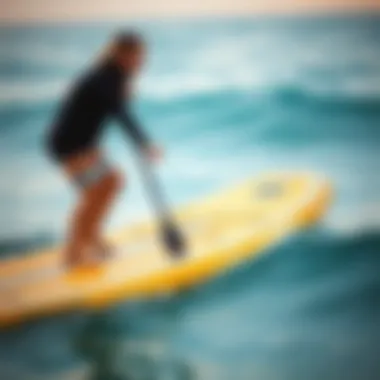
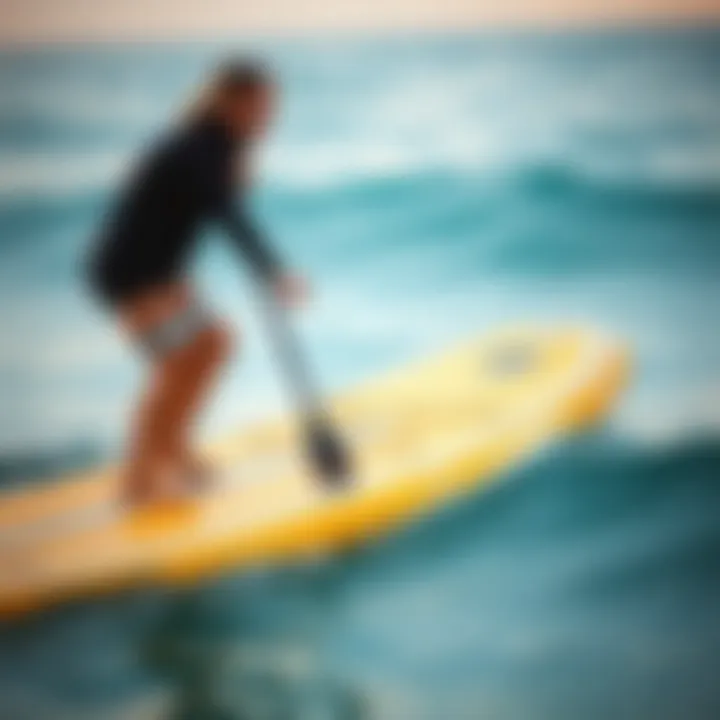
However, inflatable boards have gained traction over the years, especially in terms of convenience. They are made from tough materials such as PVC, which can endure abrasions and impacts with ease. One of their major selling points is portability—simply deflate, roll it up, and stow it away. This can be a game-changer for individuals who travel or have limited storage space. Yet, some might argue that inflatables can lose some stability compared to their rigid counterparts, particularly in rough waters. Thus, understanding the right type hinges on how and where the paddle board will be used.
Evaluating Durability and Maintenance
Choosing a paddle board isn't merely about what feels right; it involves consideration of how well the board will stand up to wear and tear. Durability is paramount, particularly for a larger individual who may impact the board more than average.
Care Tips for PVC and Epoxy Boards
When discussing care tips, both PVC and epoxy boards have their unique sets of maintenance practices. For PVC boards, it's vital to keep the surface clean and free from debris. Regular rinsing with fresh water after each use helps maintain the integrity of the material. Additionally, avoid exposure to extreme temperatures to prevent warping.
Epoxy boards, conversely, often require a bit more scrutiny. Cracks could form over time, especially after a good bump while on the water or during transport. Using a soft sponge and mild detergent to wash off salt or sand ensures the board remains intact.
It is essential to regularly inspect boards for damage—doing so can help prevent larger issues down the road.
Assessing Repair Options
Repair options play a crucial role in maintaining the lifespan of paddle boards. For inflatable boards, punctures can happen, but they are often easy to fix with patch kits that are readily available. These usually come with simple instructions, so even someone with limited handyman skills can manage the repairs.
On the other hand, rigid boards may require more technical repairs if cracks or major damage occurs. Professional repairs could be needed, which can end up costing more money and time. Knowing how easily a board can be repaired might sway buyers significantly toward one choice versus another.
Key Features for Enhanced User Experience
When it comes to paddle boarding, especially for larger individuals, the focus should be not only on the paddle board's dimensions but on features that enhance user interaction with the water. Key features can make or break the experience by providing comfort, stability, and safety. In this segment, we shall highlight two crucial components: foot straps and handles, as well as deck padding and grip.
Foot Straps and Handles
Foot straps are often a forgotten component in paddle board design, yet they provide crucial support, particularly for larger paddle boarders. A well-placed foot strap helps in maintaining balance, especially in choppy waters. While navigating through tricky waves or swift currents, these straps can help maintain control. Most boards designed for larger paddlers will have adjustable foot straps, catering to both preferences and shoe sizes.
Handles, on the other hand, aren't just for show. They offer a practical element for carrying the board to and from the water while aiding in launching and docking. A paddle board adorned with comfortable grips reduces strain on the hands and makes maneuvering easier, whether you're moving upright or when you're kneeling. Having hand grips placed in convenient spots ensures that the board can be handled more effectively, especially after a long day on the water.
Deck Padding and Grip
Comfort during Extended Use
The importance of deck padding cannot be overstated. A thicker padding ensures that standing for long periods doesn’t turn into an excruciating experience. Many boards on the market utilize EVA foam for its balance of comfort and grip. This foam can absorb shock and minimize fatigue, which is particularly important for larger individuals who might weigh down the board more significantly. Choosing a paddle board with high-quality deck padding is a popular choice among paddlers looking to maximize enjoyment during a long day out on the water.
Moreover, this padding often has textured surfaces that enhance grip and prevent slipping. On a hot day, the last thing you want is to lose your footing. Good grip means more stability and confidence as you paddle through your surroundings.
Enhanced Safety Measures
Safety should always be top of mind when out on the water, and deck padding contributes to this as well. Having a textured, reliable surface to stand on minimizes the risk of falls, which becomes a concern especially for larger paddle boarders. Furthermore, added padding can cushion the impact in case of a misstep, reducing the potential for injury. In terms of safety measures, look for boards that have built-in features like emergency handles or leash systems to secure yourself to the board in unpredictable conditions.
To sum up, the importance of these features transcends mere aesthetics. With the right foot straps, handles, deck padding, and grip, larger paddle boarders can enjoy their time on the water with increased comfort and safety. As the saying goes, it’s not just about being on the water, it’s about how you interact with it, and key features can significantly enhance that experience.
Safety Considerations for Larger Paddle Boarders
Safety is paramount for anyone who enjoys paddle boarding, but it takes on an added significance for larger individuals. Various factors come into play that merit focused attention, from buoyancy and stability to the kind of equipment used. Larger paddle boarders need to be blessed with confidence that their gear can handle their size while keeping them secure and stable out on the water. Choosing the right equipment and understanding your surroundings is crucial in order to enhance the enjoyment of this water sport.
Staying Afloat: Personal Flotation Devices
Personal Flotation Devices (PFDs) are non-negotiable when it comes to paddle boarding. They assist in keeping you afloat should you find yourself submerged, but their relevance broadens especially for larger paddle boarders who may need additional buoyancy. It’s not just about compliance with regulations; it’s about your peace of mind. PFDs designed for bigger individuals typically come with larger buoyancy ratings and comfortable adjustments. When you’re choosing a PFD, look for one that fits snugly but doesn’t restrict your movement. Remember, it’s not just a piece of equipment; it’s an essential lifeline.
Understanding Water Conditions
Paddle boarding involves far more than simply standing on a board and paddling. The water conditions play a significant role in your paddling experience, and knowing how to interpret them can be a game changer.
Calm Versus Choppy Waters
Calm waters are the go-to choice for beginner and larger paddle boarders alike. The tranquility of a placid lake or a gentle river provides a stable surface, reducing the likelihood of falling off and allowing you to focus on mastering your balance and paddling technique. On the other hand, choppy waters can offer a thrilling adventure for the more experienced. However, for those with larger frames, choppy water requires more skill and awareness, as the disturbances can make it challenging to maintain balance.
Key Characteristics of Calm Waters:
- Stable paddling surface
- Easier balance and navigation
- Increased comfort and less fatigue during longer sessions
Calm waters present a chance to learn and improve technique without the added anxiety of instability.
Risk Assessment for Various Environments
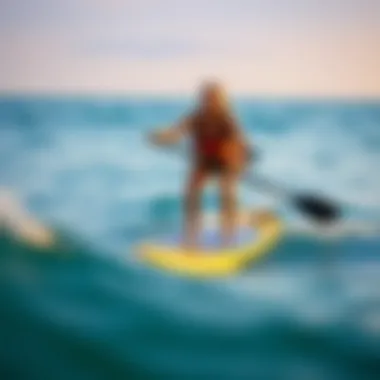
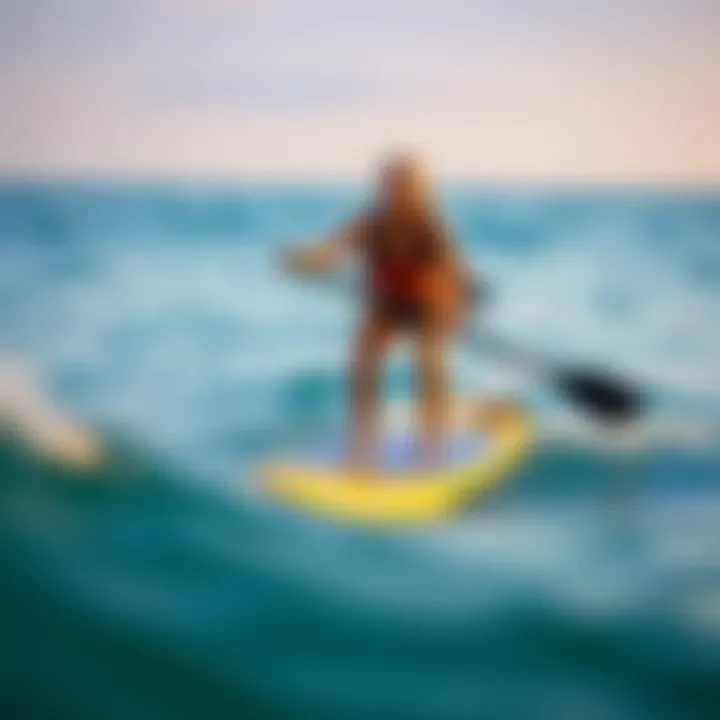
Evaluating your paddling environment is particularly pertinent for larger paddle boarders. Not all water conditions are created equal. Choppy seas or strong currents can introduce risks that require advanced techniques and experience to navigate safely.
Key Characteristics of Risk Assessment:
- Identifying potential hazards like rocks, currents, and crowds
- Understanding the weather conditions and tides
- Ability to respond to changing situations while on the water
Understanding where you are paddle boarding can mean the difference between a delightful experience or a troublesome one. Checking resources like local boating regulations or weather services can provide much-needed insights into safe paddling environments.
Always prioritize knowing the rules of the waterway, as well as the environmental conditions before heading out.
By being informed and taking safety seriously, larger paddle boarders can truly enjoy all the beauty and excitement that paddle boarding has to offer.
Maintenance and Care for Paddle Boards
When it comes to paddle boards, regular maintenance is as crucial as picking the right one in the first place. As much as one anticipates paddling out onto tranquil waters, neglecting care routines can lead to a quicker decline in performance, durability, and overall experience. By focusing on proper maintenance, larger paddle boarders can ensure that their boards remain in top condition, prolonging their life and enhancing safety. Here we’ll discuss two key elements: regular cleaning and storage practices, along with inspecting for damage—both vital aspects that every paddle boarder should keep in mind.
Regular Cleaning and Storage Practices
Cleaning your paddle board is not just about making it look good; it's about protecting your investment. Every time you take your board out, it faces salt, sand, and grime. After each session, thorough cleaning helps remove dirt and debris that can degrade materials over time.
- Freshwater Rinse: A quick rinse with fresh water can do wonders. It prevents saltwater from corroding metal parts and diminishes any build-up of sand. When you arrive home, give it a more thorough wash with mild soap and a soft brush.
- Drying: Ensure the board is dried completely before storing it away. Storing a damp board can lead to mildew, mold, and even compromise the materials over time.
- Storage Position: Always store your paddle board in an upright position or lying flat. Avoid leaning it against walls for long periods; you don’t want pressure points forming that might warp its shape.
Keeping your board free of dirt and grime not only helps in maintaining it but also ensures a safe and enjoyable experience on the water.
Inspecting for Damage
Inspecting your paddle board regularly is another non-negotiable of proper care. Just like checking your tires before a road trip, a simple visual inspection can save you from potential disasters on the water.
- Look for Dents and Dings: Unsurprisingly, larger paddle boards are susceptible to bumps, scrapes, and dings. A small dent might not seem like a big deal, but it can impact performance and create weaknesses in the structure.
- Check the Fins and Leash: Ensure that the fins are secure and not damaged. Inspect the leash, too, as a malfunctioning leash can put you in a tricky situation if you fall overboard.
- Pressure Check: For inflatable boards, regularly check the air pressure. An under-inflated board can affect its performance and stability. Be sure it maintains its shape and rigidity for optimal water performance.
Inspecting your paddle board regularly is not just about preventing damage; it's about prolonging the life of it and ensuring every outing is safe and enjoyable.
In summary, the right maintenance can keep your paddle board performing its best, catering to larger individuals who require extra stability and durability. Paying attention to both cleaning and inspections allows paddle boarders to immerse themselves in the joys of paddling, while ensuring their equipment stands the test of time.
User Experiences and Testimonials
Understanding the practical insights from users is vital when selecting a paddle board, especially for larger individuals. User experiences and testimonials present real-world perspectives that can illuminate important aspects often overlooked in product specifications or marketing gimmicks. These experiences not only validate the information provided but also help prospective buyers gauge the suitability of various paddle boards against their personal needs and preferences. The shared stories often underscore both the benefits and challenges faced, allowing paddlers to make more informed decisions.
Stories from Larger Paddle Boarders
Many individuals have found their way to paddle boarding later in life, often viewing it as a way to connect with nature and enjoy outdoor activities. It’s fascinating to hear how larger paddle boarders have tackled issues related to size, weight capacity, and stability. For instance, one enthusiast recounts purchasing a Bote Flood paddle board, which is designed with added width and a high weight limit. They found that this board provided exceptional stability, even when navigating through rougher waters.
Another paddle boarder, weighing almost 300 pounds, shared their experience with the Red Paddle Co. 10’6” Ride inflatable board. They emphasized how its buoyancy and inflatable nature allowed them to feel secure and confident while paddling into deeper water. The reassurance that the board wouldn’t capsize easily transformed their paddle boarding trips into enjoyable adventures. These individual stories are invaluable, providing insights into how certain boards perform under specific conditions.
Lessons Learned and Best Practices
From these stories arise several lessons that can guide new and prospective paddle boarders. One recurring theme is the significance of selecting a board tailored to individual needs. Here are some key takeaways:
- Test Before You Invest: Whenever possible, renting or testing multiple boards can provide firsthand insights into stability and comfort.
- Pay Attention to Dimensions: Width and length matter. Boards that are wider typically offer more stability, a crucial factor for larger paddlers.
- Consider Your Intended Use: Different paddle boards cater to different uses, such as long-distance touring versus recreational paddling. Identifying your primary goals helps in making the right choice.
- Seek Community Feedback: Engaging in forums or local paddle boarding groups can offer practical advice based on collective experiences. Websites like Reddit feature active communities where users share personal reviews and suggestions.
Ultimately, the experiences and testimonies of larger paddle boarders not only provide a sense of reassurance and relatability but also form a vital part of the knowledge base that guides others in their journey towards paddle boarding. Lessons learned from community members can save time, frustration, and investment in unsuitable boards, leading to a more joyful experience on the water.
Closure: Finding the Ideal Paddle Board
Think about the factors you’ve learned about: whether it’s the width of the board affecting stability, or the material impacting durability and weight. All these elements play a crucial role in ensuring that paddle boarding is not just enjoyable but safe and reliable. When you finally settle on that perfect board, it will reflect your individual preferences and physical needs, creating a harmonious balance between performance and comfort.
Final Thoughts on Selection Criteria
Choosing the right paddle board involves a blend of personal preferences and technical specifications. It’s about finding what fits best for you personally. Consider your paddling style, whether you're cruising along a tranquil lake or tackling swells on the ocean. Reflect on
- Weight Capacity: Ensure the paddle board can support your weight comfortably.
- Width and Length: Wideness offers stability, while length allows glide and speed in the water. The right combination significantly impacts your overall experience.
- Purpose: Are you going for a day of relaxed paddling, or will you be racing ahead? Knowing your intent can narrow down your options.
Ultimately, you want a board that's not simply a piece of equipment, but an extension of yourself that allows you to explore the waters with confidence. Remember, comfort should be a priority, especially regarding your stance and movement on the board.
Encouragement to Explore and Enjoy
Paddle boarding shouldn’t feel like a chore, rather an exhilarating adventure waiting to unfold. Given the vastness of water bodies and the joy of cruising along them, there’s always potential for discovery. Don’t shy away from trying different boards until you find the one that feels as natural as an extension of your own body. Jammed between the surface of mere recreational activity and the profound connection with nature, paddle boarding is a path to serenity.
Getting out on the water can provide a breath of fresh air, both literally and metaphorically. As you glide over the waves, every stroke should resonate with enthusiasm and ease. Let each experience refine what you enjoy and enhance your paddle boarding journey. There’s a whole world out there waiting to be explored, and with the right board, the adventure is all yours.
"The best paddle board for you is the one that enhances your experience and inspires you to return to the water continuously."
Whether you’re in it for a peaceful day on the lake or challenging yourself against nature’s forces, the journey starts with making an informed choice. Take your time, research, and most importantly, have fun out there!







